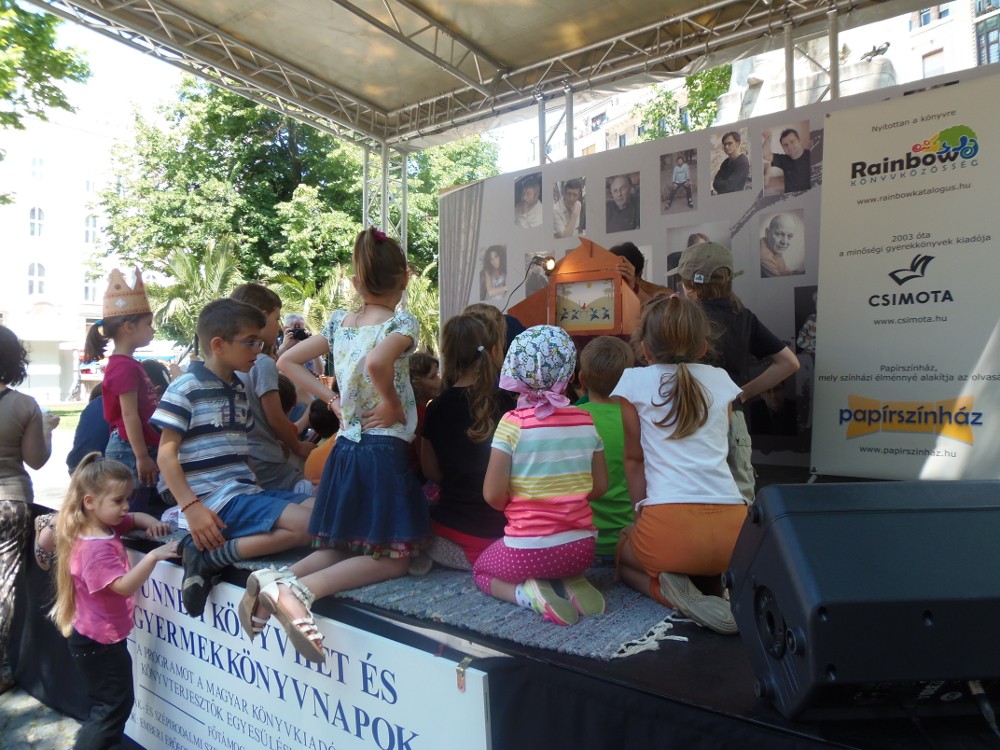The literal meaning of the Japanese word ‘Kamishibai’ is a theatre performance in paper.
Kamishibai transforms, as it were, storybooks into theatre. The person telling the tale can turn traditional storytelling into a truly theatre-like experience with the aid of large moveable cards within the wooden frame (or ‘butai’), facing the child who’s watching.
Most importantly, the paper theatre maximizes children’s attention, as it makes the images clearly visible to all; attention can therefore be paid both to the images and text. The narrator can deliver the text of the tale, printed on the back of the cards, to their audience with all the necessary impact.
There’s no more need to interrupt reading to hand the book round, and every child can now enjoy both the text of the story and the illustrations to it.
The pictures tell a story – each illustration brings to life an element of the tale. The images fill the entire card and are presented facing the audience.
On the back of each card is a smaller, black and white version of the image to let the reader know what the audience is seeing. The text is printed in large type and is easy to read, while recommendations as to when to move on to the next card are included in the relevant places in the text in italic type.
The way the cards are changed to succeed each other produces a dramatic effect for the audience. Unlike in a book, the images in a Kamishibai slide one on top the other, and thus appear one by one, each complementing the other. Sometimes, the cards are changed slowly but continuously as the reader goes through the text of the tale, while at other times, the changes come more frequently in the order marked on the back (with lines in the text); then, the reader has a small pause while everyone waits with baited breath to see what the still hidden part of the card has in store. But we can also express uncertainty and heighten curiosity by moving the cards back and forth. When the cards are moved suddenly, the emphasis is on surprise!
This way of interacting with the images lends the illustrations a dynamic quality, multiplying them, and presenting the tale like a cartoon.

It’s important, when telling a tale in Kamishibai form, to try and make the most of its possibilities by breaking up the rhythm of the reading and making it more diverse and exciting. Needless to say, based on the audience’s reaction, we can pause over one image or another. If necessary, we can communicate outside the limits of the tale itself, even asking questions, thus keeping in constant touch with our audience. We can thereby adjust the tale to their level of interest and age.
Practiced storytellers can enliven their tales with well-chosen musical excerpts.
The functionality of the paper theatres is multilayered:
1. they can be performed in a traditional way by an adult for an audience of children,
2. be made by children
The collective making of a Kamishibai presents an opportunity for communal writing and the making of illustrations. It is also an opportunity for children to express their creativity. It helps them clarify and structure their thoughts and capture the most important elements of a tale.
3. performed by children
The paper theatre helps children express themselves before an audience, structure what they have to say, overcome their fear of performing in front of their peers. They can even tell a tale before learning to read with the help of the images on the back of the cards.
4. helping children with special needs
Notable results can be achieved with autistic, hyperactive and emotionally vulnerable children; it is often helpful for verbal communication – which is not working in these children, or not working properly – to be reinforced through another channel, and helps them focus their attention. The illustrations also help support communication with deaf children.
With the help of the Kamishibai, it is easy to organize simple but exciting performances for groups of children.
